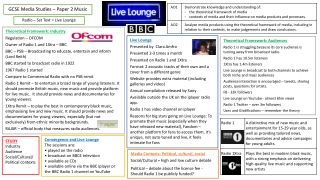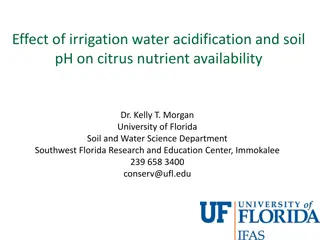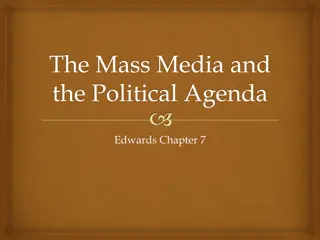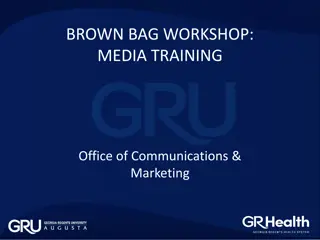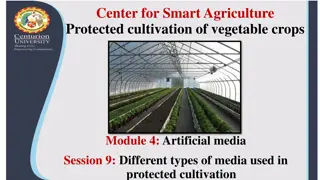Nutrient Uptake in Bacteria: Mechanisms and Factors
The process of nutrient uptake in bacteria, including the role of macronutrients, micronutrients, and environmental factors. Learn about the different mechanisms of nutrient transport and the importance of selective permeability in plasma membranes.
0 views • 25 slides
Media monopoly
Explore the implications of corporate media control on politics, culture, and democracy. Analyze the challenges faced in contemporary debates about media control. Assess the role of new communication technologies in reshaping media power dynamics. Understand the transformation of the U.S. media syst
2 views • 47 slides
Social Media Management Services | WebMaxy
Are you not getting the results you want from your social media efforts? Social media is a \"pay-to-play\" ecosystem that demands all of your resources now as much as ever: A well-organized strategy\n\nTo maximize your online presence, Webmaxy Social Media Management Tool weaves social media managem
1 views • 8 slides
Analysis of BBC Live Lounge Radio 1 and 1Xtra: Impact on Media Contexts and Regulation
The theoretical framework of media contexts in the music industry is explored through the case study of BBC Live Lounge on Radio 1 and 1Xtra. This analysis delves into the influence of industry regulation by OFCOM, audience engagement strategies, convergence in media platforms, and the societal, cul
0 views • 15 slides
Understanding Mass Media and Communication for the Academic Year 2020/2021
This content delves into the science of media, communication, and mass communication for the academic year 2020/2021. It explores the role of mass media in public communication, the characteristics of mass media, and the various types of mass media such as books, print media, films, radio, televisio
8 views • 11 slides
Grape Pomace Utilization in Soil Nutrient Management Study
Study on the mobility of total carbon, nitrogen, and polyphenols from grape pomace in soil columns, focusing on its relevance as an organic fertilizer rich in nutrients. The research also highlights the industrial potential of grape pomace, nutrient mobility between varieties, and methods used for c
1 views • 14 slides
Nutrient Requirements of Industrial Media
Microbiological media for industrial and laboratory purposes need to provide essential nutrients like carbon, nitrogen, minerals, growth factors, and water while avoiding growth-inhibitory substances. Carbon, nitrogen, minerals, and growth factors play key roles in supporting microbial growth, and t
0 views • 25 slides
New Media in India: From Fad to Fundamental
Exploring the significance of new media in India, this presentation by Dr. Sunetra Sen Narayan and Dr. Shalini Narayanan delves into the evolution and impact of new media on the global stage. With insightful data and analyses, the session addresses key issues and lessons for India and beyond, drawin
0 views • 34 slides
Understanding Plant Tissue Culture Media and Their Importance in In Vitro Growth
Plant tissue culture media play a crucial role in the in vitro growth and morphogenesis of plant tissues. The composition of culture media depends on the specific plant species and the type of material used for culture. Various types of media, such as White's medium, MS medium, B5 medium, N6 medium,
0 views • 6 slides
Understanding the Influence of Media on Body Image Perception
The media plays a significant role in shaping perceptions of body image, influencing how individuals view themselves and others. This article explores the impact of media portrayal on body image perceptions in both men and women, discussing the positive and negative influences of media representatio
3 views • 9 slides
Understanding Media Ecology: Impact of Communication Technology
Media ecology is a theoretical concept analyzing the influence of media and communication technology on human culture. Neil Postman, a prominent figure in the field, delves into how communication media affect human perception, understanding, and values. This study views media as environments shaping
4 views • 23 slides
Overview of Media Studies Disciplines and Historical Development
Media studies is a multidisciplinary field that explores the content, history, and effects of various media, with roots in the relationship between media and culture. Originating in the 1920s, media studies draws on traditions from social sciences and humanities, incorporating theories from discipli
5 views • 18 slides
Nutrient Recycling in Ecosystems
Nutrient recycling in ecosystems involves the continuous breakdown and exchange of elements between living and non-living components, ensuring sustainability and no long-term drain on Earth's nutrients. This process includes decomposition of organic material by bacteria and fungi, uptake of nutrient
1 views • 23 slides
Understanding Citrus Nutrient Availability in Relation to Soil pH and Irrigation Water Acidification
This research by Dr. Kelly T. Morgan from the University of Florida explores the impact of soil pH, irrigation water acidification, and nutrient recommendations on citrus trees affected by HLB disease. The study examines the availability of key nutrients such as Mn and Zn, the effects of different s
0 views • 23 slides
Evolution of Media Influence on Politics
The evolution of mass media and its impact on politics is explored, highlighting the important role of media events, high-tech politics, and the development of media politics through print and broadcast media. The government regulation of the broadcast media, as overseen by the FCC, is also discusse
4 views • 20 slides
Enhancing Nutrient Efficiency in Agriculture for Sustainable Systems
Improved nutrient use and manure management are crucial for sustainable agricultural systems. Efforts to increase nutrient efficiency through better practices can help reduce emissions and aquatic pollution. Public awareness, policy realignment, and soil data quality enhancements are key areas for p
0 views • 14 slides
Mechanisms of Nutrient Uptake by Microbial Cells
Nutrient uptake by microbial cells involves various transport mechanisms such as passive diffusion, facilitated diffusion, active transport, and group translocation. These mechanisms ensure the specific acquisition of required nutrients by the cell through the selectively permeable plasma membrane.
3 views • 15 slides
Understanding Nutrient Pollution and Its Impact on the Environment
Nutrient pollution, characterized by the excess input of nitrogen and phosphorus into water and air, is a significant environmental issue with far-reaching consequences. It can lead to toxic algae blooms, dead zones, economic losses, and adverse effects on human health. The causes of nutrient pollut
2 views • 11 slides
Media Studies Course Overview at Ramsey Grammar School
Learners at Ramsey Grammar School in Year 9 can expect a comprehensive Media Studies course covering various media forms such as advertising, video games, newspapers, magazines, music videos, radio, websites, and social media. The course is assessed through exams and coursework, focusing on explorin
0 views • 9 slides
European Standards for Plant Biostimulants Development
The European Committee for Standardization (CEN) plays a crucial role in developing European standards for plant biostimulants, focusing on improving plant nutrition processes independently of nutrient content. The CEN/TC.455 committee is responsible for creating standards supporting the EU Fertilis
2 views • 5 slides
Understanding Culture Media for Microorganisms
Culture media play a vital role in the growth and study of microorganisms. This content covers the primary ingredients required by all living organisms, types of culture media based on physical state, and specific media for bacteria and fungi. It explains the components and purposes of different typ
0 views • 24 slides
Media Relations Workshop Insights
Explore the importance of media training, the evolving media landscape, why working with the media is crucial, the role of media relations, strategies for media exposure, handling reporter interactions, and more. Learn how to navigate the media landscape effectively and enhance your organization's r
0 views • 17 slides
Integrated Approach to Digital Email Marketing and Social Media Strategy
Taking a tactical approach to digital email marketing and social media integration helps in creating a performance funnel for effective prospect acquisition, engagement, and conversion. The strategy includes various elements like organic and paid search, landing pages, social media engagement, nurtu
0 views • 4 slides
Importance of Traditional Media in Rural India
Rural India is rich in diverse folk art forms that hold significant cultural value. Traditional media or folk media plays a crucial role in communication, offering familiarity, acceptance, and flexibility to convey messages effectively. Despite the lack of scholarly patronage, efforts are being made
0 views • 6 slides
Nutrient Criteria Development Plan for High Rock Lake Summary Update
Nutrient Criteria Development in North Carolina has evolved through various stages since 2001, with the key milestones being the development of the Nutrient Criteria Implementation Plan in 2004 and the Nutrient Criteria Development Plan in 2014. The plan aims to link nutrient concentrations with the
0 views • 8 slides
Iowa Nutrient Pollution Control Measures and Strategies
Gulf Restoration Network Decision, sources of Nutrients Nitrogen (N) and Phosphorus (P), impacts of Nutrient Pollution leading to Algae Blooms and Gulf Hypoxia (Dead Zone), measures to reduce Non-Point Source (NPS) contamination, EPA's current strategy, and Iowa's approach with its Nutrient Reductio
0 views • 20 slides
Enhancing CareerTech Awareness Through Strategic Media Engagement
The presentation highlights the importance of engaging the media to increase awareness about Oklahoma CareerTech services. It emphasizes the need to deliver messages across various platforms to reach a wider audience. Through the media strategy outlined, the aim is to support strategic goals such as
0 views • 20 slides
Understanding Manure Management: Compositions, Nutrient Losses, and Factors
Explore the complexities of manure management by delving into manure compositions, nutrient losses, and the various factors influencing the quality and quantity of manure. Learn about the impact of animal species, diets, and management practices on manure characteristics, as well as strategies to mi
0 views • 29 slides
Understanding Nutrient Cycling in Soil for Sustainable Agriculture
Explore the intricate processes of nutrient cycling in soil, with a focus on nitrogen (N) and phosphorus (P) balances. Discover the various inputs and outputs considered within different scales, from field to country level. Gain insights into the importance of interpreting data correctly and the imp
0 views • 22 slides
Media Liaison Strategies in Sekhukhune District Municipality
Sekhukhune District Municipality employs various media liaison strategies such as the Sekhukhune Press Club, Facebook pages, press statements, and quarterly networking sessions to engage with local media effectively. They work closely with media partners including print and electronic media outlets,
0 views • 15 slides
The Impact of Cyber Media on Traditional Journalism
Cyber media, a merging of cybernetics and media theories, poses challenges to traditional journalism as it transitions to the online realm. With the rise of new media platforms, traditional journalists face uncertainty in adapting to the changing landscape dominated by citizen reporting and social m
0 views • 6 slides
Investigative Stories Unveiling Media Integrity Issues in Southeast Europe
Investigative journalism efforts supported by the South East European Media Observatory reveal corrupt practices and flaws in the media systems of Southeast Europe. Through translating data into impactful stories, journalists uncover issues such as political influence in media ownership, subversion
0 views • 8 slides
Enhancing Media Integrity in South East Europe
South East European Media Observatory focuses on media ownership transparency, concentration, and integrity in the region. Through research, reports, and grants, it aims to promote media freedom, pluralism, and ethical journalism. The Observatory identifies risks to media integrity across various ar
0 views • 26 slides
Nutrient Watershed Permit Stakeholder Advisory Group Meeting Overview
The Nutrient Watershed Permit Stakeholder Advisory Group Meeting on December 6, 2013, discussed permit components, effluent monitoring, annual reporting, treatment optimization, nutrient studies, monitoring, reporting, support for nutrient studies, treatment plant optimization, and permit timeline.
0 views • 6 slides
Understanding Human Interaction with Media - The Media Equation by Reeves and Nass
Research from "The Media Equation" by Reeves and Nass explores how humans interact with media, treating it as if it were real life. The hypothesis posits that humans respond to media just as they do to real-world interactions. Examples illustrate how individuals engage with various forms of media, e
0 views • 15 slides
Understanding Algal Culture Media for Lab Growth
Algae in natural habitats acquire essential nutrients from water, but for lab cultivation, specialized growth media are necessary. Various types of algal culture media exist, each with specific nutrient components like nitrogen, phosphorus, vitamins, and trace metals. Common media include marine alg
0 views • 6 slides
Nutrient Conceptual Model Review Summary
Comments and feedback on a Nutrient Conceptual Model report include suggestions to address issues related to eutrophication concepts, nutrient stoichiometry, community composition, and nutrient reduction goals. Recommendations also focus on incorporating flushing/residence time discussions, predicti
0 views • 9 slides
Understanding Social Media: Types, Features, and Examples
Explore the concept of social media, its definition, and various types through real-world examples. Dive into the differences between social media and traditional media, the democratization of content creation, and its significance in today's digital age. Identify common social media sites, their fe
0 views • 20 slides
Understanding Different Types of Artificial Media for Protected Cultivation
Exploring soil-less media for growing horticultural crops, this module delves into the advantages of using artificial media in protected cultivation. From soil mixes to peat, perlite, and vermiculite, learn how these components offer benefits like improved aeration, nutrient control, and labor effic
0 views • 21 slides
Understanding the Landscape of New Media in Russia: Insights from BRICS Study
The BRICS study delves into the realm of new media in Russia, shedding light on emerging trends and the evolving digital landscape. From the proliferation of online media to the digital footprint of Internet users, the research offers valuable perspectives on the dynamic media environment within the
0 views • 42 slides



